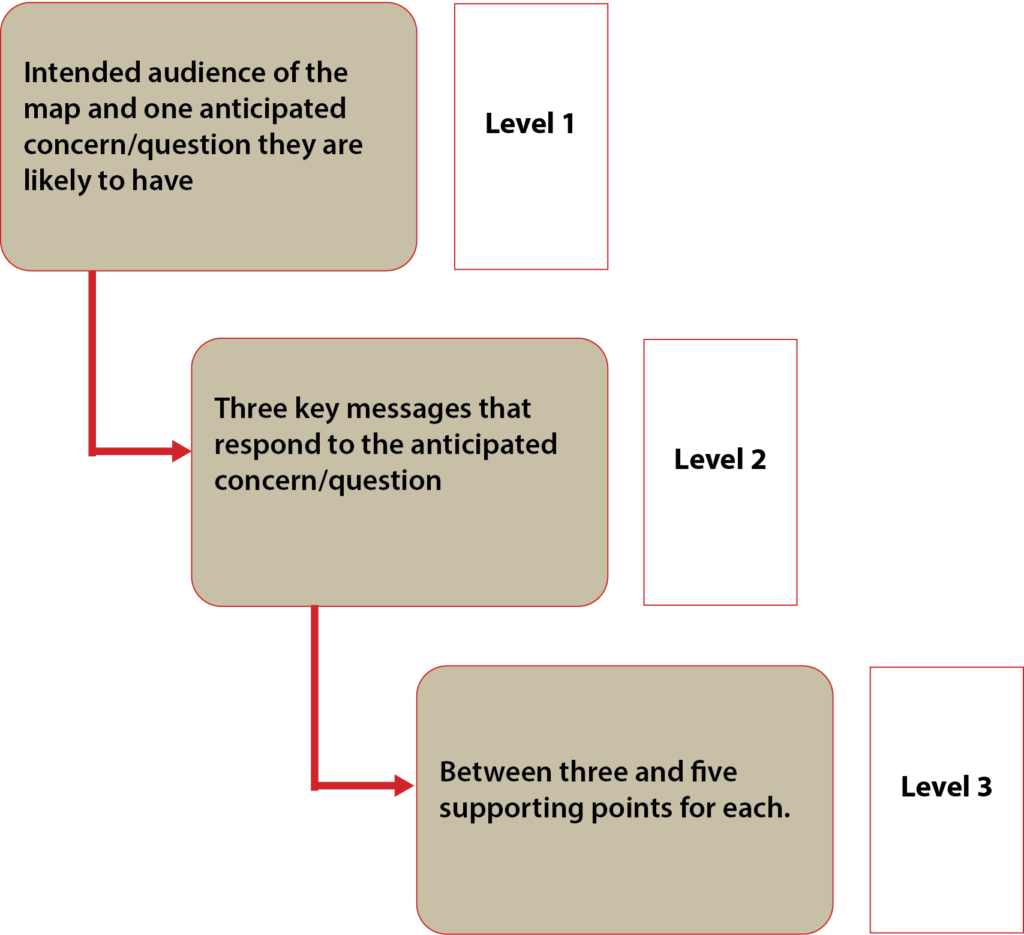Develop Message Maps
Communication at the onset of an emergency is particularly challenging as fear and anxiety can affect the ways in which the public responds to messages, what information they retain and how they perceive it.
One method that is recognized and recommended for developing consistent messages during an emergency is the use of message maps. Message maps are a useful tool that provides factual information about the emergency that can be shared quickly with partners and the media to ensure that information is delivered in a consistent, clear and concise manner.
Message maps describe hierarchically organized information in three levels to anticipated or actual questions and concerns from audiences about the emergency. The graphic below provides a brief description of each of the three levels of information in a message map.

Audiences for message maps are generally wide-ranging and can include:
- The general public
- Individuals directly affected by the emergency
- Individuals who are indirectly affected by the emergency
- At-risk and vulnerable individuals
- Service providers (including health, emergency and law enforcement)
- Decision makers
- Authorities and government bodies
- Organizations involved in the response
- The media and the press
Each audience segment should have its own message map, with each map addressing one separate concern. The table below describes the information that makes up each level of the message map. See a completed example of a message map.
| Audience | Insert the audience to whom this message map is addressed. It can be as broad as “the general public,” or more specific. For example, the media, decision makers or at-risk individuals. Each message map should target ONE audience only. |
| Concern or Question | Insert ONE anticipated concern or question that the audience is likely to have regarding the emergency. Examples include: “How is Ebola spread?”; “What is cholera?”; “What does one do to stop the outbreak?”; “What are the signs and symptoms of avian influenza?” |
|
Key Message 1: Insert one message that can help answer the selected concern/question. |
Key Message 2: Insert a second message that can help answer the selected concern/question. |
Key Message 3: Insert a third message that can help answer the selected concern/question. |
| Supporting Points: Write between two and five points with information that supports and clarifies the key message. | Supporting Points: Write between two and five points with information that supports and clarifies the key message. | Supporting Points: Write between two and five points with information that supports and clarifies the key message. |
Message maps can be developed for as many audiences as necessary, and to address as many questions/concerns as anticipated for each audience group. It is likely that, in the pre-crisis and initial phases of an emergency, message maps will mostly target the general public and the media.
In areas where known emergencies can occur, message maps should be developed during the pre-crisis phase so that they can be quickly accessed and distributed immediately at the onset of an emergency to support harmonized messaging. As the emergency evolves, message maps can be fine-tuned to respond more specifically to arising questions that populations and individuals may have.
Undoubtedly, the key messages are an essential component of message maps, and it is important that these are developed following some simple guidance. The table below provides a list of Do’s and Don’ts of message development.
Although message maps are typically developed following seven recommended steps, the following worksheet provides some simple guidance on developing your own message maps for an emergency. It is advisable to complete this worksheet together with partners and stakeholders. When developing messages, consider indicators and communication objectives (Unit 6).
| Do's | Don'ts |
|---|---|
|
|

